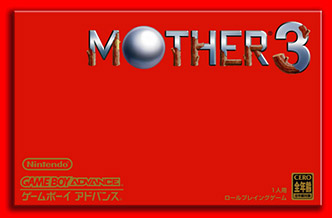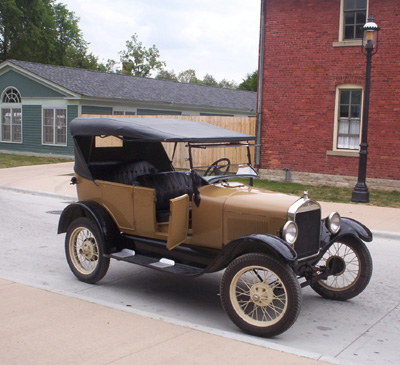I recently finished playing the Japanese Role Playing Game (JRPG) Mother 3 in its fan translation. This was an excellent game which continues the series tradition of great writing, fun game play and wonderful music. Let's start with a bit of background.
The Mother series of JRPGs is the brain child of the famous author and copywriter Shigesato Itoi and many of his traditional themes are developed in the series. Mother began as something of a joke. It's conception commenced after one day (I think he was stuck sick, but I can't remember where I read this), Itoi decided to play DragonQuest III (a new hit game at the time). He became intrigued by its simplistic, shonen manga-like writing and found himself narrating along to the battles. Itoi, at the time a well known advertiser, decided to approach Shigeru Miyamoto - the creator of Mario and others - with a pitch for a video game set in modern day with preteen characters. They developed a friendship and professional relationship that would end up being very important - Itoi, for instance, was the one who convinced Miyamoto to drop Ultra from the name "Nintendo Ultra 64". This was one of the first "celebrity" video games, and recall that the last time a celebrity made a joke video game it didn't go so well. We're lucky we got what we did.
Mother (in English, EarthBound Beginnings) is a very important series for the history of JRPGs. It's design (in particular, the way it approached the world map) clearly influenced Pokemon and Itoi's gentle but epic tone helped pave the way for the approach later Nintendo games, such as some of the Legend Of Zelda games or Super Mario Galaxy, would aim for. That being said, it isn't hard to tell that its the work of someone who doesn't have much experience making games. It's unbalanced and obviously not very play-tested. And moving to the third hand, the soundtrack was a huge, unexpected success, to the point that it was decided to release the soundtrack in a traditional form. (Yes, that is the most 80's thing in history, but in a fun way)
The second game in the series, called Mother 2 in Japan and EarthBound in English, is the big epic of the series. I'm going to do a lot of comparison between Mother 2 and 3 later, but let's talk about the place of EarthBound in the biz first. First of all, its tagline was "Adults, children, and even older sisters.". Normally one wouldn't talk about a tagline as being important - but remember that Itoi is a copywriter/advertiser first and a video game designer 12th or 15th. From a business perspective Itoi, Miyamoto and Iwata (another very important Nintendo higher-up) had the goal of making a game that would reach beyond the so-called "otaku" young male nerd market and appeal to "older sisters". In order to do this, Itoi aimed to make a game with a plot, themes and style that would speak to ordinary people. Therefore, the general goal was to avoid, say, dragons salivating over nubile elf princesses. I think the right comparison would be to Steven Speilberg's film E.T. vs ... maybe, Frank Herbert's Dune. The mainstream audience isn't interested in the machinations of the mentat Thufir Hawat against the House Harkonnen (even though technically, they're all human). They find it much easier to see little Eliot find his place in the world through friendship and hardship. A sci-fi adventure in a world with chrysanthemums and Reese's Pieces is just plain more interesting to normal people (sorry fellow SF fans). The advantage of a long development time, much larger space and much more powerful machinery allowed Itoi to explore and decorate the world of Ness's adventure much more intricately. One of his goals, for example, was to fill the world with whimsical and useless things - much more like our own than the typical RPG where every little thing matters. And, like EarthBound Beginnings to some extent, this game used a deliberately cartoony, Peanuts-like art style to emphasize its difference with the shonen manga style prevalent among JRPGs then and now.
Claus, clay sculpture
Well, now that we know where Mother 3 came from, we can talk about what it is. I'm going to leave spoilers to a special spoiler section. Let's start with the characters, setting, plot and what have you.
Lucas, clay sculpture
Like its predecessor EarthBound, Mother 3 has a rich cast of characters. There's main character Lucas (pictured above), ninja/bassist Duster, enslaved dancing monkey Salsa, punk rock girl Princess Kumatora, serious rancher & father Flint, mysterious giant Leder (an obvious Twin Peaks reference, which I am always on the look out for), cruel and banana loving merchant Fassad, the sexless Magypsies, the lovably egotistical Rope Snake (I was not expecting this to even be a character, much less the hilarious one he was) and many more besides. Itoi really went out of his way to try to make the characters encompass many personalities. For instance, the aforementioned Duster has partial paralysis in his left leg. In a "normal" game, he would have ended up without this quirk. But in Mother 3 it's just allowed to be part of who he is. It's not often in video games that a character is just allowed to be disabled like that. That being said, there sure aren't many black people....
Partially as a result of this diversity, there are a surprising number of gay jokes in Mother 3, which I really wasn't expecting. The sexless Magypsies, for instance, hew pretty closely to crossdressing okama stereotypes. I found them funny, you might not.
The Nowhere Islands provide our quirky setting and its hidden secrets. More than the islands themselves, the game centers on Tazmily Village, a utopian place where people do what they want for each other because they want to. If you bring nuts to one woman, she bakes them into bread. The local "store" has items sitting on the ground. The jail has never been used, because there isn't any crime. The plot of Mother 3 requires the various leads to continuously return to Tazmily Village and watch how it evolves. Money is invented, alienated labor is introduced and commodified entertainment is brought in as a pain killer. Dangerous politics are played with as the borderline-fascistic Pigmasks control access to good employment (and, by extension, the entertainment). Itoi does a good job of avoiding being preachy or boring with these ideas, which is pretty amazing. The Pigmasks are people who the characters develop relationships with, the foreman is even appreciative of all the work your doing. The aforementioned commodified entertainment is a band that really does love music and its audience. It would have been easy to go the lazy route and make the Pigmasks inhuman jerks and the band pro-slavery sloganeers, but it would also be cheap. And avoiding the cheap turned out to be pretty important a the secrets of the Nowhere Islands are slowly revealed...
Character design from an early, 3D version of Mother 3
Mother 3 has basically the same art style as EarthBound, which is great because - as you can see above - early 3D art looked terrible and is now extremely dated. The march of time allows Mother 3 to do a lot more with what it has than EarthBound. There's some funny animation in there, not just having the sprites move up and down. Needless to say, the music is uniformly excellent, which even plays a role in game play. If the player presses the attack button in sync with the music, they'll perform an extra attack (up to 16). However, these extra attacks do little extra damage and clash with the way the damage is tabulated. Like in EarthBound, when a player character is hit their health rolls downward over time. If one is quick, a character can be fatally injured several times over and still be in battle. Healing a sufficiently large amount instantly reverses the counter, saving the character from dropping out of the battle. These tactics, however, cannot be combined with the amount of time it takes to do 16 hits.
While I'm complaining, it really annoyed me that my PP wasn't refilled after boss battles. I don't know why, but sometimes it seemed not even my health was replenished. Unlike EarthBound, enemies don't run after you've beaten the local boss, so this made for some painful limps home (I never died because of this, but it was annoying). These are my only complaints about the game play, which otherwise is loads of fun.
Before we move on to spoilers, I want to do more comparison with EarthBound. In some ways, Mother 3 is a superior game. I mentioned already the animation and variety of characters. I'm also happy to add that the most annoying game play flaw of EarthBound - dealing with an inventory system full of useless quest items - has been completely addressed. Quest items are now helpfully tucked away in their own space. Though the plots are very different, both games are basically a Hero's Journey (some argue that all stories are a hero's journey and this may be so, but they aren't all helpfully described as one). But, in my opinion, Mother 3 simply feels less epic than EarthBound. It may be the case that on a technical level, the Nowhere Islands are larger than Eagleland. But Ness's quest feels like more of a quest. I think that a lot of it has to do with the fact that Lucas is constantly returning to Tazmily Village (until the very end), while Ness is going from city to city. The overall thrust is the same: Ness goes from the comfort (and free room & board) of his family through a succession of larger and more expensive cities - meanwhile, Lucas sees Tazmily village from the primitive, utopian togetherness of the beginning to seeing it become a post-industrial semi-ghost town as everyone moves to the big city. But with more literal distance, Ness's journey feels like ... more of a journey. Only in the last chapter is Lucas really all that far from home. By the time you control him, he's already over his fearfulness from the first two chapters. It would be nice to have been part of that experience. Ness's process of growing up was represented in game play in a very clever way - at lower levels he was prone to suddenly become homesick and would randomly fight sub-optimally. Since Ness is by far the most powerful character, this could be very dangerous! After you've leveled up enough this stops happening. Lucas's growth process doesn't directly affect game play. It may or may not help that a major reveal in Mother 3 is the way it is tied into EarthBound, which made me feel as though the game I was playing was sort of a side game and the "real EarthBound 2" was about Ness's reaction to Porky's message at the end of that game...
SPOILERS
There are two stages to the major reveals of Mother 3.
The first happens once you reach Chapter 7, the centerpiece of the game. It is revealed that the Nowhere Islands are on top of a sleeping, godlike power known as The Dragon. This is hinted at very early in the game. The ageless Magypsies are tied to magical objects known as The Needles, which keep The Dragon slumbering. Only a chosen hero can remove The Needles, and I don't think I'm breaking any hearts when I reveal that the lead character happens to be chosen. Whoever should draw The Needles will have control over the nature of The Dragon when it awakes. Oh, and by the way - your creepy fascist enemies have someone who can draw needles too...
The second round of reveals take place in New Pork City. The most obvious reveal is the true nature of your creepy fascist enemies. They are controlled by Porky Minch, who you might recall from EarthBound. As you recall, traveling through time and across universes left him insane, immortal and very powerful. Leder, the mysterious giant from the first few chapters, goes on to reveal more secrets around this time. The world that the Nowhere Islands exist in is on the border of being completely destroyed. The power of The Dragon keeps the Nowhere Islands from themselves collapsing into the chaos of the surrounding world. The original inhabitants of the Nowhere Islands (which they called the Kingdom Of Oshoe) are gone, only the Magypsies remain. The current inhabitants are refugees from the destroyed outside world who wiped out their memories to try to make their new civilization peaceful. Only Leder was left with the memories to reveal in case it was necessary, otherwise the magical Egg Of Light kept the memories suppressed.
Now comes the speculation. How does this world exist in reference to the original EarthBound? Where are the Nowhere Islands in comparison to Eagleland? It's usually assumed that the Nowhere Islands are just somewhere in Eagleland's future, only thousands or even millions of years later. We know Porky can travel across worlds as well as time, so his presence proves nothing. However, there is another hint that this is the same world - Lucas's family has Ness's Franklin Badge (which plays an important role in the plot, so it's clear we were supposed to notice this connection). Again, to play the third blackbird in Wallace Stevens's tree, this is not quite conclusive evidence since the badge is obviously supposed to be connected to Benjamin Franklin, so it might not be necessarily Ness's Franklin Badge (I have a hard time swallowing this though).
Let's posit the Nowhere Islands exist parallel to Eagleland for a moment. What consequences could that possibly have? I think this theory's chief virtue is the sense it makes of Porky's loneliness. Porky can travel across infinite spaces and flit through time at random, but he can't do the one thing he wants - gain the love and respect of the people he cares about. He nearly completely destroyed the world in which the Nowhere Islands exist, because his only remaining goal in "life" (if you can call a being in his state "alive") is to destroy "everyone who doesn't like [him]". Even Porky can see the pointlessness of destroying the world - in many ways his plans in Mother 2 and 3 are brilliant. His plan in Mother 2 was the more sensible conquest after all. But if it is just one world among many, it becomes easier to see his behavior from his end as a game. The Dragon is just another omnipotent psychic monstrosity to unleash on another doomed little world, just as Giygas was in the original worldline. Because of this, I think that it is best to think of Mother 3's setting as being parallel to EarthBound's (or at least, so far in the future that they might as well be).
It has the side advantage of not canceling out Mother 2's ending as well.
NO SPOILERS
So, that's about all I have to say about this game for now. It's a great game that I recommend to anyone with the 20 or so hours to spare it take to play it. Have fun!




No comments:
Post a Comment